Swaziland’s rail system is 40 years old this month. Built to haul freight (iron ore to Maputo en route to Japan), Swaziland Railway today remains exclusively cargo-oriented.
Judging by the low interest loans from nations like Italy and Taiwan to rehabilitate tracks and rolling stock, the company has allies that want it to succeed. They recognise the value of reliable, scheduled rail transport to bring in raw materials for the growing garment factories and take out finished goods for export. 100% of Swaziland’s coal, the last mineral to be mined in any quantity in the country, is transported by rail.
“We do more import than export,” said Stevenson Ngubane, marketing director for Swaziland Railways. “Road transport has more flexibility for finished goods, but there are times when a scheduled service is required.”
A few months ago, the final kilometres of rail were rehabilitated, and trains, after rumbling along at speeds as low as 20 kph, once again operate at the system’s designated speed of 60 kph.
Trains leave most weekdays at 16:00 and arrive at Durban 19 hours later, at 11:00. The train arrives back at the Matsapha Dry Port (the hub of the industrial estate’s activities, also known as the Inland Container Depot) at 06:00 the next morning.
Some freight agents complain of Spoornet’s handling of Swazi freight at Durban, but Ngubane is sympathetic.
“It’s a large yard with a great amount of traffic. They are doing the best they can,” he said.
Rail rehabilitation speeds up trains
22 Jun 2004 - by Staff reporter
0 Comments
Transport Into Africa 2004
22 Jun 2004
22 Jun 2004
22 Jun 2004
22 Jun 2004
22 Jun 2004
22 Jun 2004
22 Jun 2004
22 Jun 2004
22 Jun 2004
22 Jun 2004
